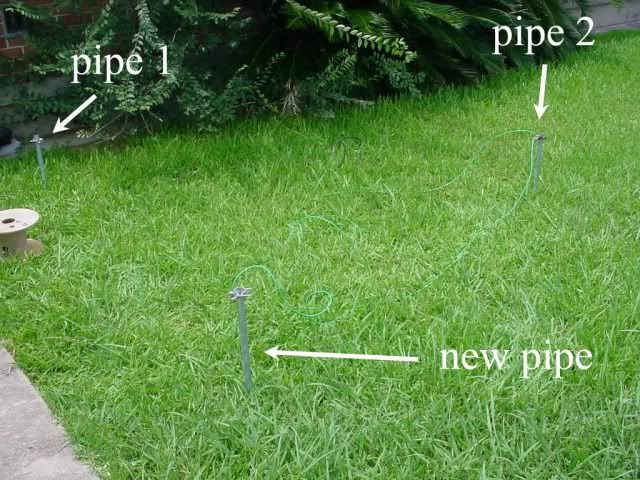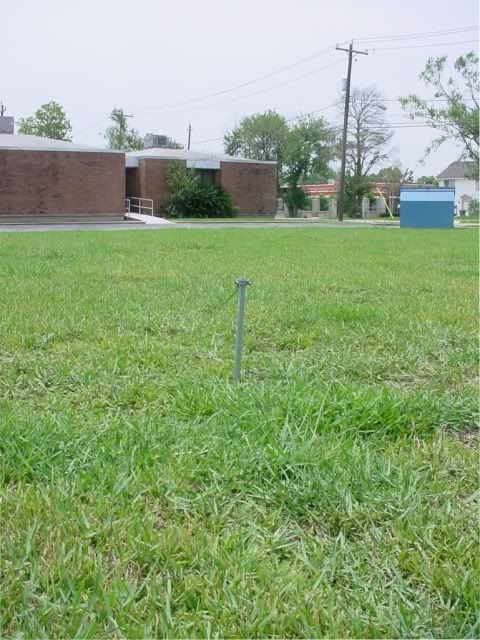crossman gary
Senior Member
Note 1: I placed this thread in the NEC forum because the original "Grounding Electrode Conductor Question arose here. Moderators, if it needs to be moved, have at it!
Note 2: This is a follow-up to the thread: http://forums.mikeholt.com/showthread.php?t=115917
Did more experiments today. It rained hard on Saturday night, so there is water in the ditches and the soil is pretty wet... wetter than it was on Saturday morning when I did the original experiment. My thoughts were that this would make the earth conduct even better. I was right as will be shown.
I drove 3 more pipes into the ground at various places. These are 5 foot long 1/2" rigid pipes. I drove them in about 4 feet, leaving 1 foot sticking up.
Here are photos of the locations.
Pipe 1 is the pipe that I used on Saturday. It was driven in 3 feet, I went ahead and drove it down one more foot. As I mentioned, each pipe is 5 feet of 1/2" rigid, driven 4 feet into the ground. Pipe 2 is driven in the grassy area, about 6 feet from pipe 1. The photo was taken after I did pipe 1 and pipe 2 in parallel, hence the wire between them.
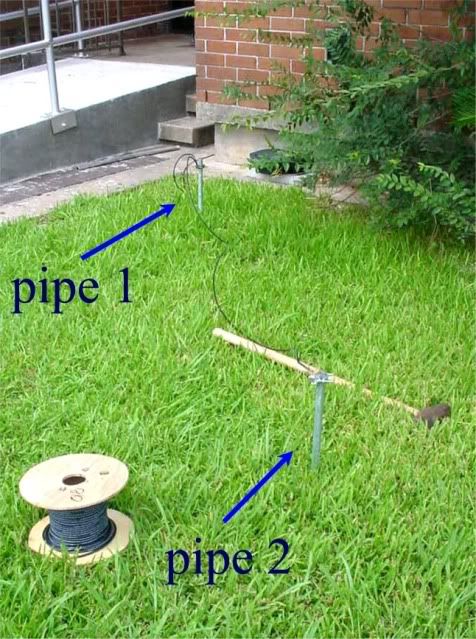
Pipe 3 was driven right next to the ditch. You can see there is water there. Plus, the city water main runs under there somewhere, I am guessing it is around an 8" steel pipe. I figured that this pipe should be pretty conductive at that location. BTW... the power pole right there... it has a bare ground wire coming down to about 2 feet above the soil, and it is cut off there. Nothing going in the soil.
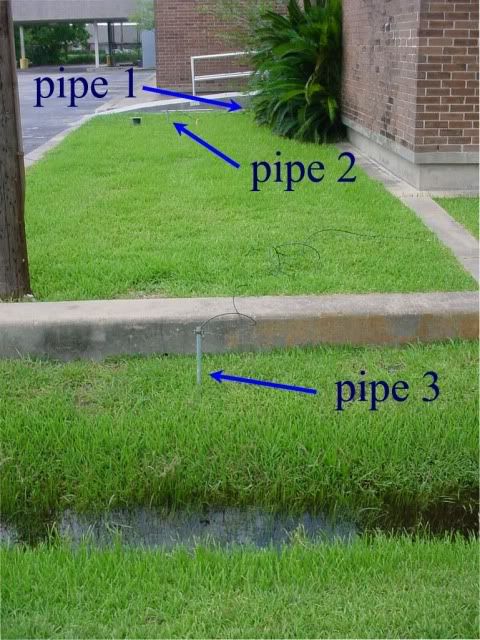
Pipe 4 was driven across the parking lot, about 60 feet from pipes 1 and 2. I figured this one wouldn't be too good. It is in a 1 acre vacant lot. There is a dumpster sitting to the right, you can see the lid in the photo.
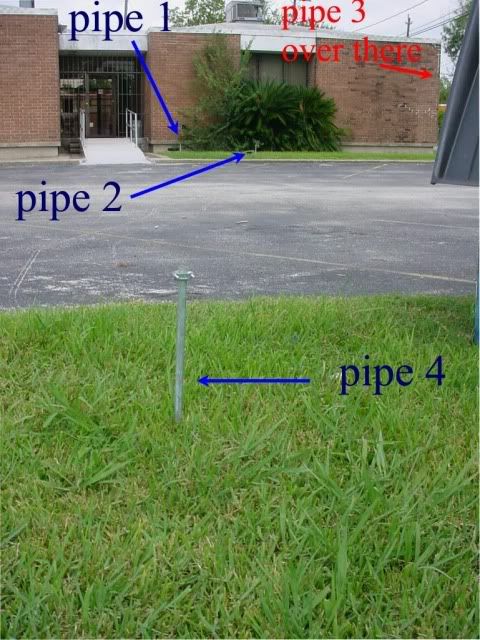
Here are photos of the lab equipment:
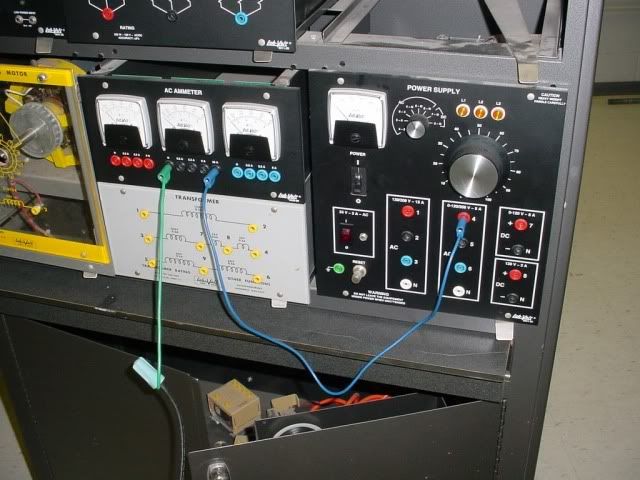
And the #8 wire going outside to the pipes.
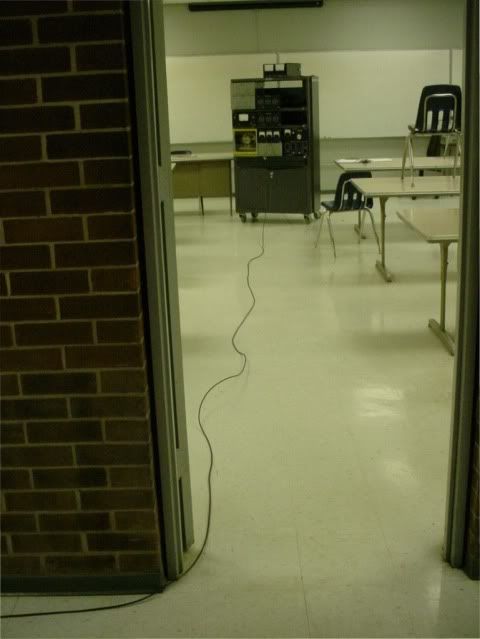
The power supply has a varible voltage 0 to 120v supply. In the previous experiment, I thought that the OCPD was 15 amps. As someone mentioned, I believe it was Hurk27, that the 15 amps was for the non-variable supply. he was right. The 0 to 120 volt unit says 0-120v 5 amps. So we will take that to mean the OCPD for that portion is 5 amps.
I tested each pipe seperately by connecting the #8 to the pipe, then slowly turning up the voltage and recording the current measurements. Now, the meters are fairly small analog type, so the numbers I give you are only accurate to about 1/2 an amp. That isn't a concern, as the overall trend is what is important.
After I did each pipe seperately, I connected pipe 1 and 2 in parallel and tested them together.
Here is a table showing my results:
Volts....Pipe 1...Pipe2...Pipe 3...Pipe 4...Pipe 1 and 2 in parallel
20........3..........2.........4..........2................5
40........7..........5.........8..........5................11
60........10........7.........11.........8...............trip
80.......trip........9........trip........10
100..................trip..................trip
Pretty significant current! The 5 amp OCPD was tripping at around 11 amps.
Again, the recent rain probably had a marked effect on these results. If we have another 2 week drought, I feel the currents would be much lower.
Another thing I am wondering about is if it matters that the pipes were freshly driven or if they have been in the ground for months. I wonder if that could affect the contact between the earth and the pipe. Does the "grip" and "pressure" of the earth to the pipe diminish over time as the compressed soil spreads?
Any comments?
Note 2: This is a follow-up to the thread: http://forums.mikeholt.com/showthread.php?t=115917
Did more experiments today. It rained hard on Saturday night, so there is water in the ditches and the soil is pretty wet... wetter than it was on Saturday morning when I did the original experiment. My thoughts were that this would make the earth conduct even better. I was right as will be shown.
I drove 3 more pipes into the ground at various places. These are 5 foot long 1/2" rigid pipes. I drove them in about 4 feet, leaving 1 foot sticking up.
Here are photos of the locations.
Pipe 1 is the pipe that I used on Saturday. It was driven in 3 feet, I went ahead and drove it down one more foot. As I mentioned, each pipe is 5 feet of 1/2" rigid, driven 4 feet into the ground. Pipe 2 is driven in the grassy area, about 6 feet from pipe 1. The photo was taken after I did pipe 1 and pipe 2 in parallel, hence the wire between them.

Pipe 3 was driven right next to the ditch. You can see there is water there. Plus, the city water main runs under there somewhere, I am guessing it is around an 8" steel pipe. I figured that this pipe should be pretty conductive at that location. BTW... the power pole right there... it has a bare ground wire coming down to about 2 feet above the soil, and it is cut off there. Nothing going in the soil.

Pipe 4 was driven across the parking lot, about 60 feet from pipes 1 and 2. I figured this one wouldn't be too good. It is in a 1 acre vacant lot. There is a dumpster sitting to the right, you can see the lid in the photo.

Here are photos of the lab equipment:

And the #8 wire going outside to the pipes.

The power supply has a varible voltage 0 to 120v supply. In the previous experiment, I thought that the OCPD was 15 amps. As someone mentioned, I believe it was Hurk27, that the 15 amps was for the non-variable supply. he was right. The 0 to 120 volt unit says 0-120v 5 amps. So we will take that to mean the OCPD for that portion is 5 amps.
I tested each pipe seperately by connecting the #8 to the pipe, then slowly turning up the voltage and recording the current measurements. Now, the meters are fairly small analog type, so the numbers I give you are only accurate to about 1/2 an amp. That isn't a concern, as the overall trend is what is important.
After I did each pipe seperately, I connected pipe 1 and 2 in parallel and tested them together.
Here is a table showing my results:
Volts....Pipe 1...Pipe2...Pipe 3...Pipe 4...Pipe 1 and 2 in parallel
20........3..........2.........4..........2................5
40........7..........5.........8..........5................11
60........10........7.........11.........8...............trip
80.......trip........9........trip........10
100..................trip..................trip
Pretty significant current! The 5 amp OCPD was tripping at around 11 amps.
Again, the recent rain probably had a marked effect on these results. If we have another 2 week drought, I feel the currents would be much lower.
Another thing I am wondering about is if it matters that the pipes were freshly driven or if they have been in the ground for months. I wonder if that could affect the contact between the earth and the pipe. Does the "grip" and "pressure" of the earth to the pipe diminish over time as the compressed soil spreads?
Any comments?

